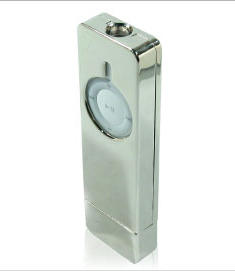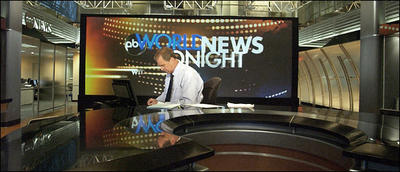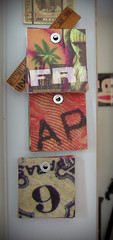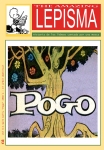Libraries offering audiobook downloads
GUILDERLAND, New York (AP) -- A new way to borrow audiobooks from the library involves no CDs, no car trips, no fines and no risk of being shushed.
Rather, public libraries from New York City to Alameda, California, are letting patrons download Tom Clancy techno-thrillers, Arabic tutorials and other titles to which they can listen on their computers or portable music players -- all without leaving home.
Librarians say such offerings help libraries stay relevant in the digital age.
Barbara Nichols Randall, director of the Guilderland Public Library in suburban Albany, said the library considered the needs of younger readers and those too busy to visit.
"This is a way for us to have library access 24/7," she said.
There's still one big hitch, though: The leading library services offer Windows-friendly audiobook files that can't be played on Apple Computer Inc.'s massively popular iPod player.
Vendors such as OverDrive Inc. and OCLC Online Computer Library Center Inc.'s NetLibrary have licensing deals with publishers and provide digital books using Microsoft Corp.'s Windows Media Audio format, which includes copyright protections designed to help audiobooks stand apart from the often lawless world of song swapping.
A patron with a valid library card visits a library Web site to borrow a title for, say, three weeks. When the audiobook is due, the patron must renew it or find it automatically "returned" in a virtual sense: The file still sits on the patron's computer, but encryption makes it unplayable beyond the borrowing period.
"The patron doesn't have to do anything after the lending period," said Steve Potash, chief executive of OverDrive. "The file expires. It checks itself back into the collection. There's no parts to lose. It's never damaged. It can never be late."
Potash said about 1,000 libraries have signed up for OverDrive's audiobook service since its debut late last year. NetLibrary, teaming up with Recorded Books, launched a similar service in January and counts 200 library customers.
Libraries offering audiobook downloads range from large institutions in New York and Los Angeles to smaller ones for Cleveland, Ohio, Maricopa County, Arizona, North Little Rock, Arkansas and Omaha, Nebraska. The Hawaii State Public Library System signed up earlier this month.
Guilderland pays NetLibrary about $6,000 a year for more than 850 titles. Randall considers that a good deal, noting that a single audiobook can cost the library up to $80 when bought on CD.
Under the NetLibrary program, Guilderland gets a set number of downloads for all titles each year, and a single title can be borrowed by multiple patrons simultaneously as long as the cap hasn't been reached. Downloads over the cap cost extra. Patrons must provide their own audio players, although they may listen on their home computers if they do not have one.
Other libraries make different arrangements. OverDrive, for example, generally takes a more traditional approach. When a copy is checked out, no other patron may download it until the borrowing period ends.
It's still unclear what impact such services will have on audiobook download sales from companies such as Audible Inc., although one analyst suggested it could inspire more sales as patrons buy for keeps a title they had borrowed.
"It's certainly smart for the publishers to do this," said Phil Leigh, a senior analyst with Inside Digital Media.
Digital downloads are a part of a natural progression for libraries, which have evolved from lending books to cassettes and videotapes to CDs and DVDs. OverDrive recently launched a video download service for libraries.
Librarians say they had little interest in audiobook downloads just a few years ago, but they have since noticed what everyone else has: the ubiquity of people sporting earbuds on streets, buses and malls.
Nearly 28 million portable audio players were sold last year, according to In-Stat, a technology research company. With more than 21 million sold, the iPod remains the signature portable player. But it uses the Advanced Audio Coding format with FairPlay, its own digital rights management system and one incompatible with Windows' technology.
Just as the lack of a standard digital audio format has fragmented the music download market, it affects audiobooks.
Users of iPods can still listen to books purchased through sources such as audible.com or Apple's own iTunes Music Store, but the library services, for now, are geared toward computers and devices that support Windows Media Audio files. OverDrive files can be burned to CDs and converted to iPod friendly formats, but NetLibrary's cannot.
Marge Gammon of NetLibrary said that despite iPod's cache, the company wanted a product that could be played on a range of devices. OverDrive's Potash notes there's a growing market of portable audio players, some priced lower then $50 (Regular iPod models start at $299, though the Minis start at $199 and Shuffles at $99).
Apple spokeswoman Natalie Kerris said the company has no plans to change its copy-protection formats and would not comment on the incompatibility issue.
Librarians say they have heard complaints from iPod users, but there's little they can do beyond waiting for the industry to sort out its differences.
One California library shunned the download services completely, largely because of iPod's popularity. Instead, Newport Beach Public Library bought 15 iPod Shuffles and loaded them up with audiobooks from iTunes to loan out.
Patrons are liable for any loss or damage, though librarian Genesis Hansen said there's been no problems so far.
Copy, right? 2005 The Associated Press. All rights reserved.This material may not be published, broadcast, rewritten, or redistributed.
Original Source That's Right,
HMK




































































